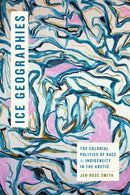Description
Jen Rose Smith is a dAXunhyuu (Eyak, Alaska Native) geographer interested in the intersections of coloniality, race, and indigeneity as read through aesthetic and literary contributions, archival evidences, and experiential embodied knowledges. She received her Ph.D. from UC Berkeley in Comparative Ethnic Studies and her Master's Degree from the same department, and holds a BA in English Literature and the Environment from the University of Alaska, Southeast. Her book Ice Geographies: The Colonial Politics of Race and Indigeneity in the Arctic is forthcoming from Duke University Press in May 2025. She has published in Environment and Planning D: Society and Space, Vogue Magazine, and The Geographical Journal.
Ice animates the look and feel of climate change. It is melting faster than ever before, causing social upheaval among northern coastal communities and disrupting a more southern, temperate world as sea levels rise. Economic, academic, and activist stakeholders are increasingly focused on the unsettling potential of ice as they plan for a future shaped by rapid transformation. Yet, in Ice Geographies, Jen Rose Smith demonstrates that ice has always been at the center of making sense of the world. Ice as homeland is often at the heart of Arctic and sub-Arctic ontologies, cosmologies, and Native politics. Reflections on ice have also long been a constitutive element of Western political thought, but it often privileges a pristine or empty “nature” stripped of power relations. Smith centers ice to study race and indigeneity by investigating ice relations as sites and sources of analysis that are bound up with colonial and racial formations as well as ice geographies beyond those formations. Smith asks, How is ice a racialized geography and imaginary, and how does it also exceed those frameworks?
Table of Contents:
Acknowledgments ix
Prologue: Glaciers Nowhere, Everywhere, and Somewhere xiii
Introduction: Careful Guessing 1
1. Ice as Analytic 31
2. Ice as Data 60
3. Ice as Imaginary 84
4. Ice as Terrain 106
5. Ice Among the Stars 140
Conclusion: Ice as Soft 165
Epilogue: Ice and Emptiness 172
Notes 177
Bibliography 195
Index 221


